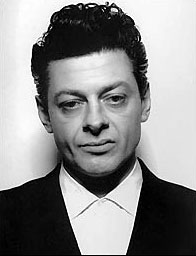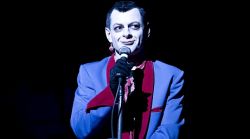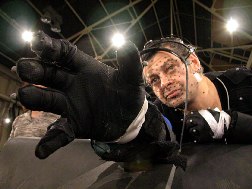The career of Andy Serkis tends to point in one direction: darkness visible. Onstage, more recently on screen, he has inhabited a series of characters for whom violence is second nature. His Bill Sikes was utterly deranged, though a pussycat next to his Ian Brady in Longford (pictured below), whose ghastly charisma he seemed intuitively to understand. Serkis’s performance-captured Gollum gave global audiences the creeps. And that was him somewhere under the computer-generated fur as the ultimate unreconstructed he-man Kong. Whence it is but a small step to Ian Dury. In sex&drugs&rock&roll, Serkis plays the polio punk with a lot of hit in his rhythm stick.
Serkis’s Dury is incubating enough latent anger to power the lighting rig at the gig where we first meet him. All those childhood years in an institution for the disabled, plus a tendency to violence fired by drink and drugs, laced with chronic frustration at professional failure both before and after his time in the spotlight – they are all ingredients for spontaneous combustion. This mockney urban poet could pick a fight in an empty room. Of course he has charm to spare, but equally he might revert to cruelty and rage as fast as you can say “das ist gut, c’est fantastique”. In a career full of them, this scintillating performance is Serkis’s most detailed portrait of a nutter yet.
 With such a back catalogue, any interviewer would be entitled to a flicker of worry as they step into the room. Apart from the odd foray into the non-psychotic domain, Serkis has almost never not scared the living bejesus out of his audiences. The most half-normal person he’s played in recent years is the discoverer of the theory of relativity in Einstein and Eddington. It turns out that he’s an even better actor than the public evidence suggests because in person he is, needless to say, quite the honeybunch: all purring smiles and blokey openness. A semi-snatched chat in a hotel room as part of a promotional junket is hardly the psychiatrist’s couch, but the question needs asking: what on earth attracts an apparently stable actor to explore the dark side so relentlessly?
With such a back catalogue, any interviewer would be entitled to a flicker of worry as they step into the room. Apart from the odd foray into the non-psychotic domain, Serkis has almost never not scared the living bejesus out of his audiences. The most half-normal person he’s played in recent years is the discoverer of the theory of relativity in Einstein and Eddington. It turns out that he’s an even better actor than the public evidence suggests because in person he is, needless to say, quite the honeybunch: all purring smiles and blokey openness. A semi-snatched chat in a hotel room as part of a promotional junket is hardly the psychiatrist’s couch, but the question needs asking: what on earth attracts an apparently stable actor to explore the dark side so relentlessly?
The scary answer is that he’s just holding up the mirror to the rest of us. “We are all capable of horrific things,” he says. “We have intrusive thoughts that would put us in prison like that if we enacted them.” He snaps two fingers. “I suppose I am fascinated by how people create their own moral universe and how they can live with themselves as they go about the most abhorrent acts, how they live with themselves day to day, because we all do it to a greater or lesser extent. I like the challenge of experimentation into the darker side of reality. You just get a chance to do that more if you play characters on the fringes of society.”
There was a time, he explains, when he was a younger man and less able to put characters back in the box, that the work affected him more deeply. At the Royal Court in April de Angelis's Hush (1992), he played a schizophrenic homeless youth who, having killed his dog and taken on its spirit, breaks into a household. “I was completely naked onstage the whole time. That took a long time to go away.” He also cites the yuppie he played in Mike Leigh’s Career Girls (1997). “I got into a mindset which was not mine. You become isolated. You get sucked into the world, there’s no question. But I think I’m better at managing it.”
He attributes the change to family. With the actress Lorraine Ashbourne he has three children. In terms of their dad bringing the role home, the worst they've had to put up with is two years' exposure to the music of Ian Dury. One of them was recently hauled up before the beak for over-familiarity with a particular lyric: “I was to be straight, I want to be straight,/I’m sick and tired to taking drugs and staying up late.”
Serkis first heard “Hit Me with Your Rhythm Stick” during a school camping trip. He was 14. Until then, with three older sisters, his musical soundscape had been all Fleetwood Mac, Steely Dan and Supertramp. “I heard him on the radio and that was it. I thought, who the hell and what is that? You could hear this voice that wasn’t saying anything that you’ve ever heard before, something that was exotic and magic and weird and yet dangerous and thrilling.”
A Serkis kind of singer, in short. Perhaps it was only a matter of time before he ended up playing Dury. He was duly approached three years ago by the scriptwriter Paul Viragh, only for the pair of them to discover that the producer Damian Jones was also working on a Dury biopic. They chose to merge projects, with the ambition not to tell the straight story of the life, the work and the death (Dury died of liver cancer 10 years ago at 57), but something more impressionistic.
The result is a film which is only partly about music. As well as portraying Dury’s puppyish relationships with women, it equally explores the vexed area of fathers and sons. According to the film’s reading, Dury romanticised a distant father and was hardly the conventional dad himself to his son Baxter (immortalised as the young punk standing next to his old man on the cover of New Boots and Panties!!). Dury’s first act of paternal unorthodoxy was to rehearse loudly downstairs in the front room with his band Kilburn and the High Roads as the boy is being born upstairs.
While this is a matter of documented fact, a lot of what the film posits isn’t. The entire narrative is framed as a Brechtian musical performance, with Dury as a face-painted MC at the microphone (pictured below), and Viragh’s script happily mucks about with the facts. “What we were trying not to do was go, ‘In 1978 he went to the Hope and Anchor...’ We want it to be a universal film. We never wanted it to be an arthouse drama doc about Ian Dury. We were taking liberties with storytelling all over the place, because as he says in the film, ‘Never let the truth get in the way of a good story.’”
 That said, the truthfulness of Serkis’s performance is hugely persuasive: Dury’s demented shtick, all scabrous vowels and bug-eyed charisma, is a slamdunk for an actor like Serkis. He makes all the standard noises about doing his own version of Dury. “When I say it’s not an impersonation, what is more important is getting a balance between the spirit of the man and where that crosses over into yourself as a performer. When we actually did the live gig stuff I didn’t just want to mimic Ian onstage. That would be a Madame Tussauds/Stars in Your Eyes version. What I wanted to do was my version of him singing live in the moment and putting those songs across.”
That said, the truthfulness of Serkis’s performance is hugely persuasive: Dury’s demented shtick, all scabrous vowels and bug-eyed charisma, is a slamdunk for an actor like Serkis. He makes all the standard noises about doing his own version of Dury. “When I say it’s not an impersonation, what is more important is getting a balance between the spirit of the man and where that crosses over into yourself as a performer. When we actually did the live gig stuff I didn’t just want to mimic Ian onstage. That would be a Madame Tussauds/Stars in Your Eyes version. What I wanted to do was my version of him singing live in the moment and putting those songs across.”
Much as he gave hugely nuanced performances as Gollum and Kong, he can’t help being conscientious here. With chief Blockhead Chaz Jankel involved not only as a character but the film’s composer, and Baxter Dury retained as a consultant, Serkis also did his bit. Dury fans won’t be able to complain about the voice or the antics or the contorted gait of the polio sufferer. Serkis went to the trouble of losing two stone and building up his right-side musculature, wearing a calliper and even consulting with Dury’s widow on how he rolled a spliff with only one functional hand.
Underlying all the usual preparations, Serkis was also aware of an invisible rockbed of empathy. They grew up a few miles apart – Dury in Harrow, Serkis in Ruislip - and both studied art before switching to their chosen profession: Dury at Walthamstow College of Art, Serkis at Lancaster University. And as a child Serkis also had a distant relationship with his father. The family’s roots are Armenian: the surname was originally Serkisian. Earlier in the last century the Serkisians dodged the pogroms by emigrating to Iraq, where Serkis was born in 1964. After his mother brought the four children to London when he was one, his father remained a doctor in Baghdad, and for 14 years Serkis visited him every summer.
But there is another kind of kinship which made it easier to think his way into Dury’s head: “that of a creative person who could if the devil took him that way be completely consumed by a creative energy.”
 This is the last we’ll be seeing of Serkis for a while, at least facially. Having spent much of the last decade in performance-capture mode, first in The Lord of the Rings trilogy and then King Kong (pictured right as Kong), he will again disappear behind a digitised disguise to provide the voice and physical movements of Captain Haddock in Steven Spielberg’s forthcoming version of The Adventures of Tintin: Secret of the Unicorn. (Although already shot, it doesn't open till next year.) And then he’s back in the employ of Peter Jackson as Gollum returns in the two-part version of The Hobbit. He's been around the technology so long he has seen it develop from "a tin shed with six motion capture cameras and you could only move about one foot right or left without it all crashing. Now you’ve got huge studio spaces with multiple actors running around."
This is the last we’ll be seeing of Serkis for a while, at least facially. Having spent much of the last decade in performance-capture mode, first in The Lord of the Rings trilogy and then King Kong (pictured right as Kong), he will again disappear behind a digitised disguise to provide the voice and physical movements of Captain Haddock in Steven Spielberg’s forthcoming version of The Adventures of Tintin: Secret of the Unicorn. (Although already shot, it doesn't open till next year.) And then he’s back in the employ of Peter Jackson as Gollum returns in the two-part version of The Hobbit. He's been around the technology so long he has seen it develop from "a tin shed with six motion capture cameras and you could only move about one foot right or left without it all crashing. Now you’ve got huge studio spaces with multiple actors running around."
No actor has devoted quite so much time to roles in which we see almost nothing of him. “I quite like that though,” he says. “I love being subsumed in a character. I find that liberating.” And he is adamant that his computerised characters are as rounded as any. “You’re just looking for what drives that character. What is the psychology? With Gollum it’s a lust and craving for the ring. I treated him very much as an addict. With Kong, gorillas are social creatures. Our take on Kong was that he was this lonely psychotic hobo and that finally gets a chance to connect it actually transforms him. It was the only romantic lead I’ve ever played. Apart from Ian."
Watch a clip of Andy Serkis playing Gollum:














Add comment